Connecting via the Aeries SIS
The Aeries OneRoster API, developed by Aeries, is based on the OneRoster 1.1 specification. OneRoster is an industry standard for the secure exchange of data between applications and student information systems.
Note For information on mapping Aeries data to OneRoster, see Aeries to OneRoster data mapping.
This documentation covers the following:
Setting up Claris Connect in Aeries
Claris Connect must be authorized to access the Aeries OneRoster API before connecting to the SIS. For the purpose of authentication, you set up Claris Connect as a product in the Aeries OneRoster API for your district’s portal. You will use the Client ID and Client secret from this setup when connecting to Aeries to create your flow.
After you complete this task, your users can use the Aeries connector in Claris Connect. You do not need to perform this task again unless your district’s Aeries domain changes or your Aeries account expires.
Note You must have access to the Aeries portal and know the credentials for your district’s Aeries account.
To set up Claris Connect in the Aeries OneRoster API:
-
Go to the Aeries portal, and sign in with your organization’s username and password.
-
In the left pane of the Aeries page for your district, click Security > Security API.
-
In the Product table on the API Security page, click OneRoster.
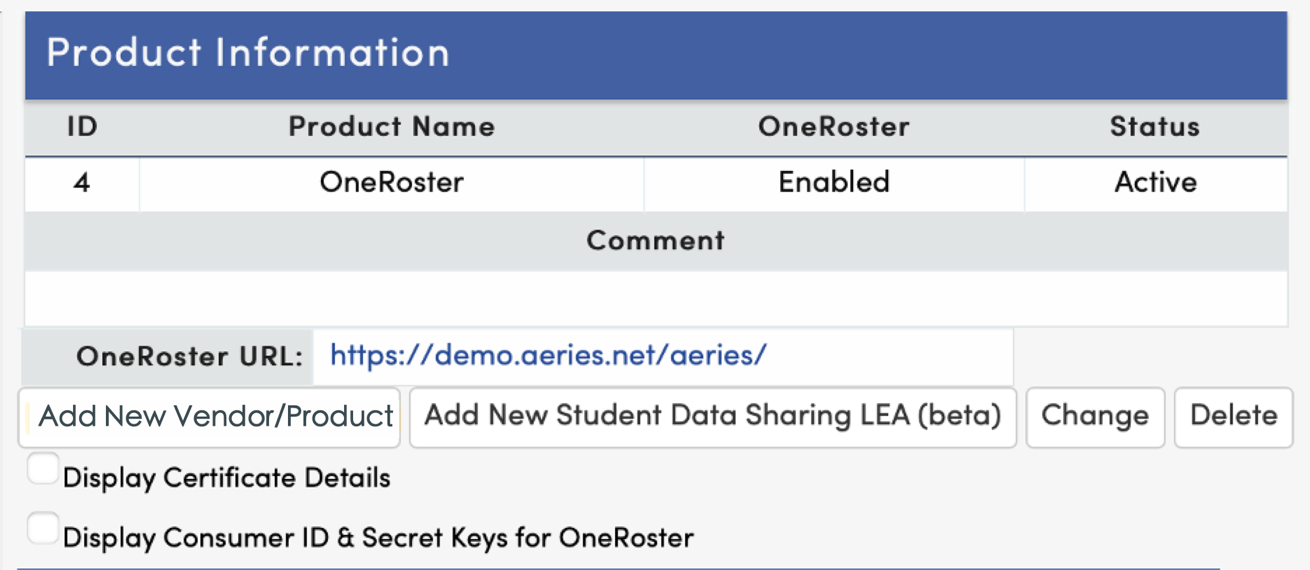
-
After the page refreshes, click Add New Vendor/Product.
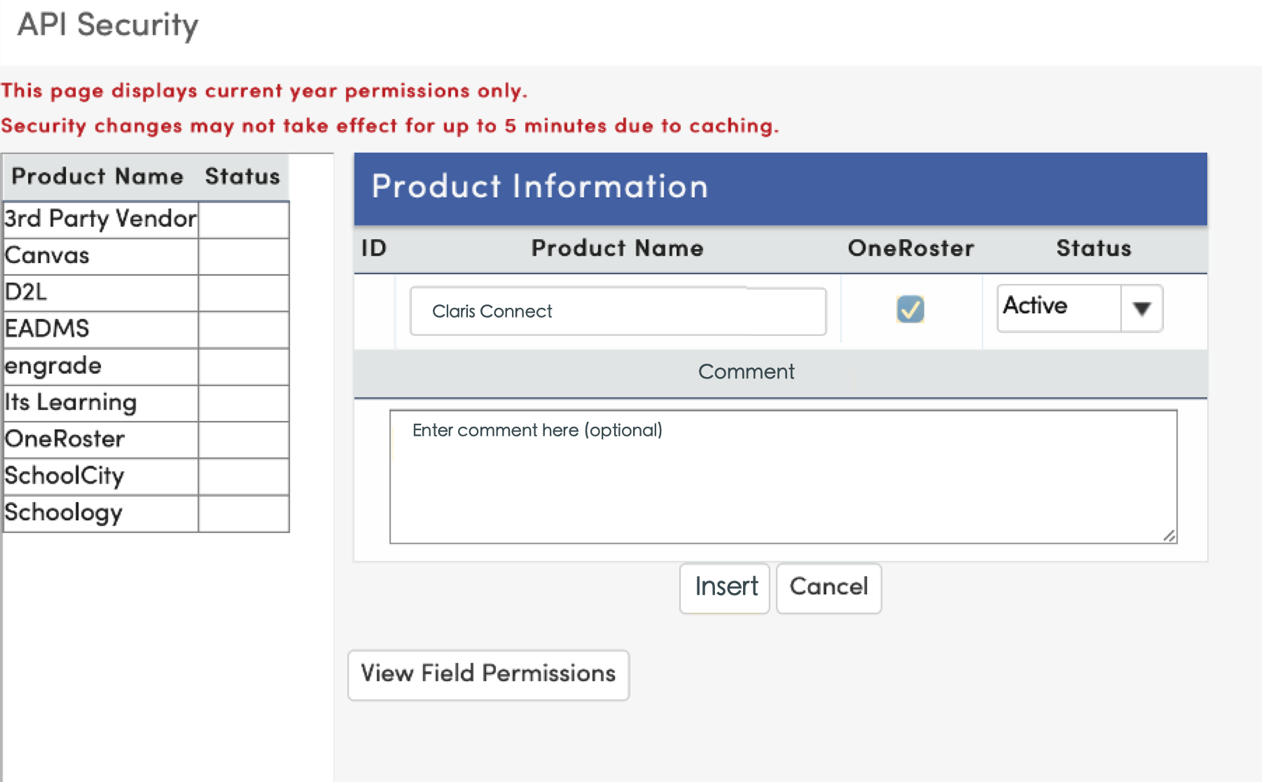
- On the API Security page, which shows OneRoster as Active, perform these actions:
For Product Name — enter Claris Connect.
Select the OneRoster checkbox.
For Comment — (Optional) enter a comment to describe the API security settings.
Click Insert to save the settings, which updates the API Security page to show your new product information.

-
On the API Security page, select Display Consumer ID & Secret Keys for OneRoster.
Note You will use the Consumer (Client) ID and Client Secret when you connect your Aeries account in Claris Connect. You can either return to the API Security page, or copy them to a note for quick access.
-
In the Permissions table, select the Read checkboxes to enable read access to data for Claris Connect. The table below lists the OneRoster data that should have Read access.
Permissions Read Access Student Data Student Data Yes Student Programs Special Programs Yes Supplemental Data Yes District Supplemental Data Yes Contacts Yes Class Schedules/History Yes Attendance Absence Code Table Yes Attendance Yes Attendance History Yes Bell Schedule Yes Calendar Yes Enrollment History Yes Test Scores Test Scores Yes College Entrance Tests Yes Other Student Pictures Yes Gradebook Gradebook Data Yes Gradebook Scores Yes Gradebook Category Yes Gradebook Assignment Yes Scheduling Teacher Data Yes Staff Data Yes Master Schedule Yes Course Data Yes Classes Yes Grade Reporting Grades Yes Transcripts Yes Graduation Status Yes School Information Schools Yes Terms Yes Users Yes Multiple LEA Student Sharing Graduation Status Yes Student Data Yes Student Documents Yes Student Pictures Yes Supplemental Attendance Yes -
On the left pane in Aeries, click School Info > School Options.
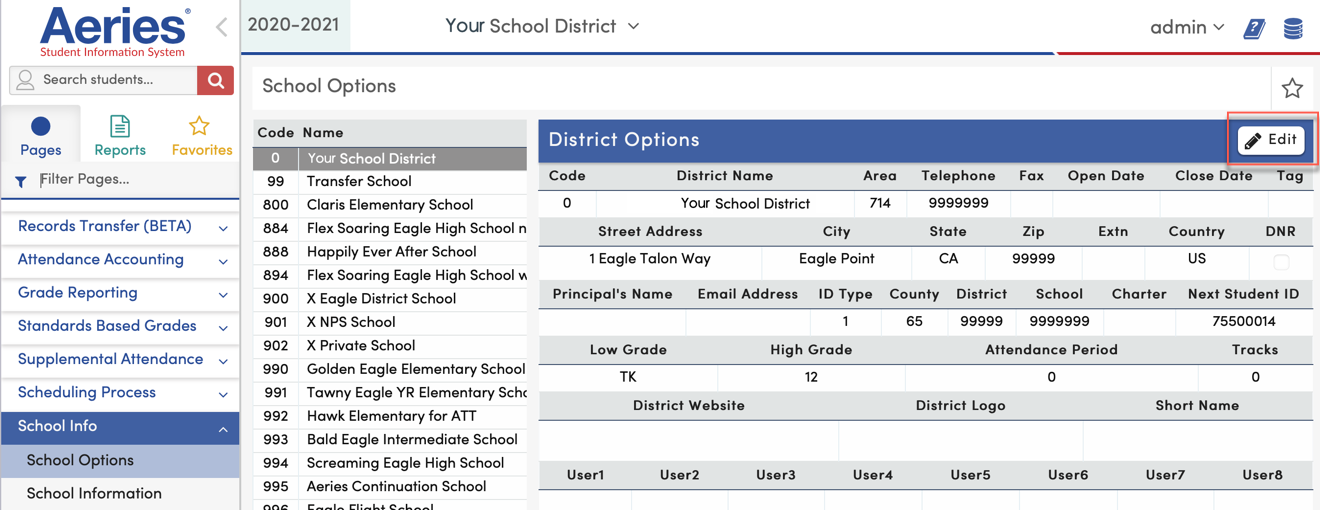
-
On the School Options page, click Edit (with the pencil icon) at the top right.
-
In the OneRoster Settings section, click Enable to make the OneRoster URL reachable from Claris Connect.
-
Click Save.
The Claris Connect product settings, including API security and OneRoster data permissions, are saved.
About the daily data sync to Apple School Manager
For the prerequisites for connecting your SIS and Apple School Manager, see Claris Connect for Apple School Manager User Guide.
When you are ready, use the Scheduled Sync to Apple School Manager template to create your flow in Claris Connect. The template wizard walks through these preconfigured steps:
-
Connect: Sign in to the Apple School Manager and Aeries SIS accounts
-
Configure:
-
In Step 1, you set up the trigger, which initiates the flow run. For the trigger, you specify when the flow will run using the Claris Connect Schedules utility.
-
Step 2 is automatic and requires no configuration by you. Step 2 consists of the processing and transfer of the Aeries SIS data to Apple School Manager.
-
Finish: This step also requires no configuration, and takes you to the project that is automatically created to house your flow.
-
Creating your flow from the template
-
Go to https://connect.claris.com/.
-
Sign in using your Managed Apple Account and password.
You land on either the Projects or Templates tab. If you don’t have any projects, the Templates page appears.
-
Click the Aeries icon. The Introduction page of the Aeries template wizard appears.
-
Review the information needed to complete the template setup, and click Next.
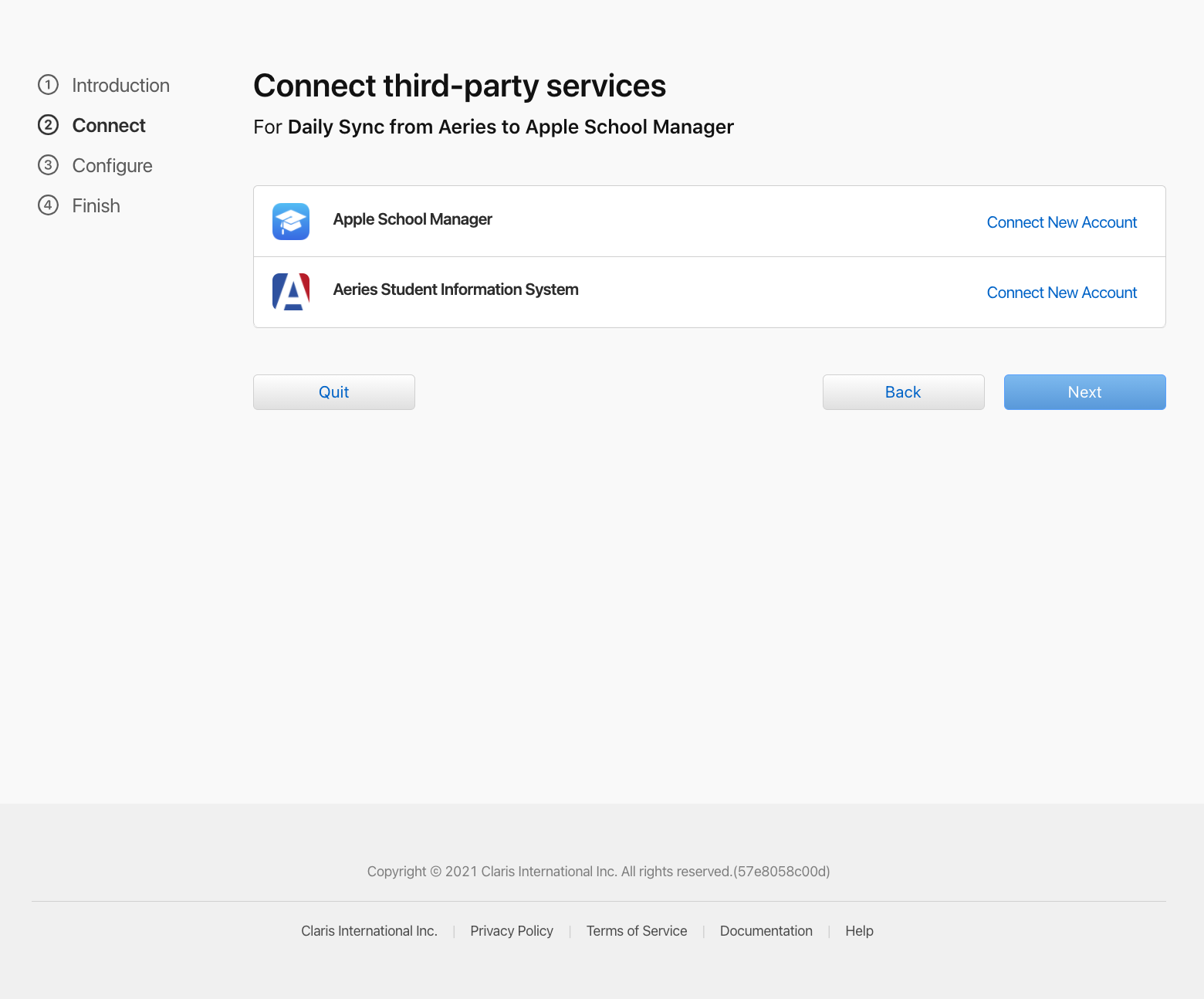
-
On the Connect page, next to Apple School Manager, click Connect New Account.
-
In the Apple School Manager dialog box (which has the SFTP domain pre-filled), perform these actions:
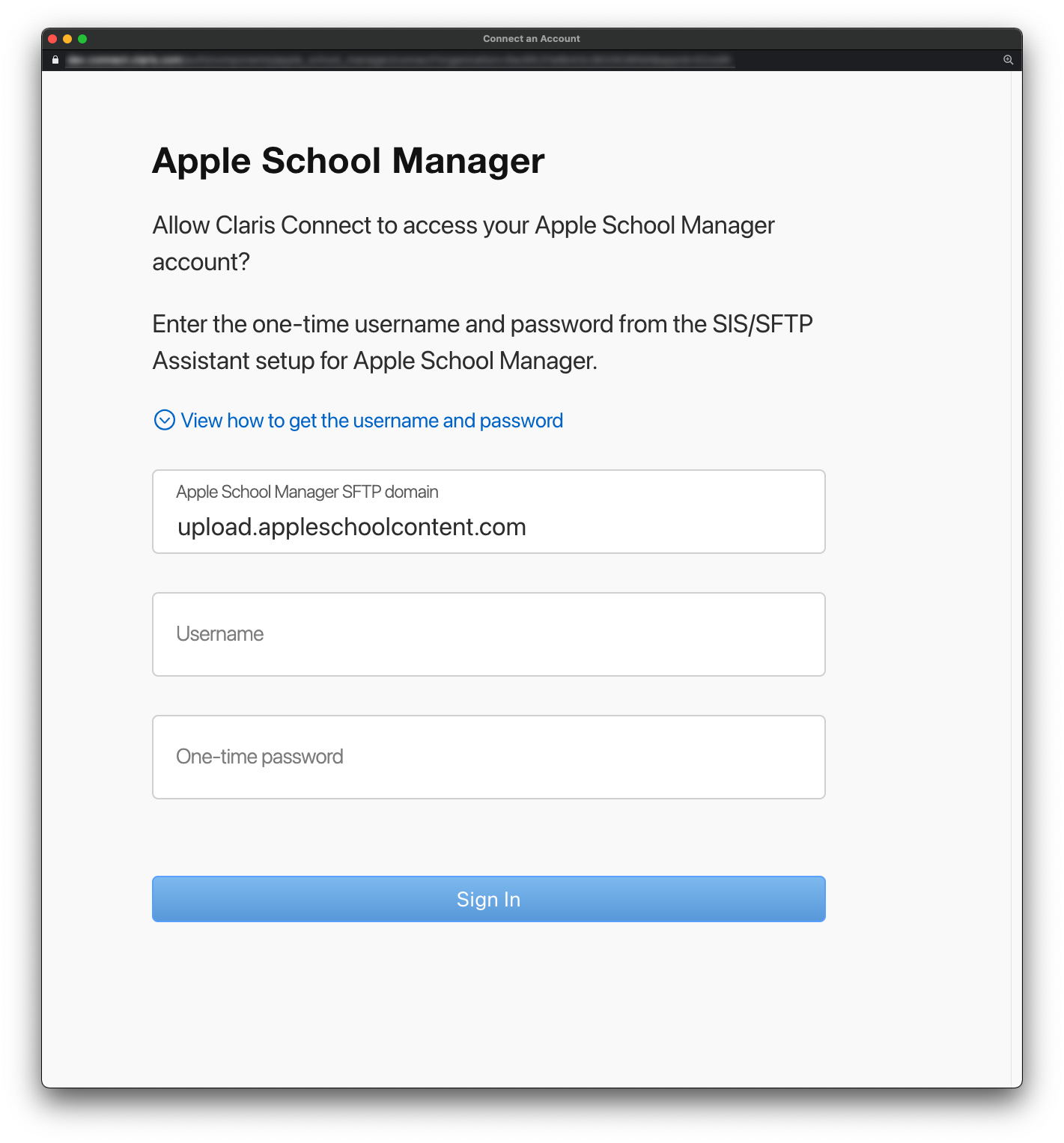
-
Click View how to get the username and password for information on the username and one-time password in Apple School Manager.
-
Open a new browser window and sign in to Apple School Manager.
-
Copy and paste the username and then the password from Apple School Manager into the dialog box, and click Sign In.
-
-
On the Connect page, next to Aeries Student Information System, click Connect New Account. The Aeries dialog box appears.
-
Click View how to obtain these credentials for information on getting the Client ID and Client Secret from the Aeries portal.
-
Open a new browser window and sign in to the Aeries portal.
-
Copy the credentials from the portal into the Aeries dialog box, and click Sign In.
-
-
When both accounts are connected, click Next.
-
On the Configure page, set the hour and time zone for when you want the flow to run, and select whether it should run on the weekend (True is yes, and False is no).
Tips
-
To choose a US time zone, first type US/ in the box for the time zone list.
-
Choose an hour when there is little activity on your SIS portal. Schedule the flow to run on the weekend only if there is activity then.
-
-
Click Next to go to the Finish page, then click Go to Project.
A dialog box prompts you to turn on saving request and response data for the project.
-
To turn on the option for saving request and response data, click Start.
You can view the request and response data for each step of a flow run on the History tab. See Viewing flow history.